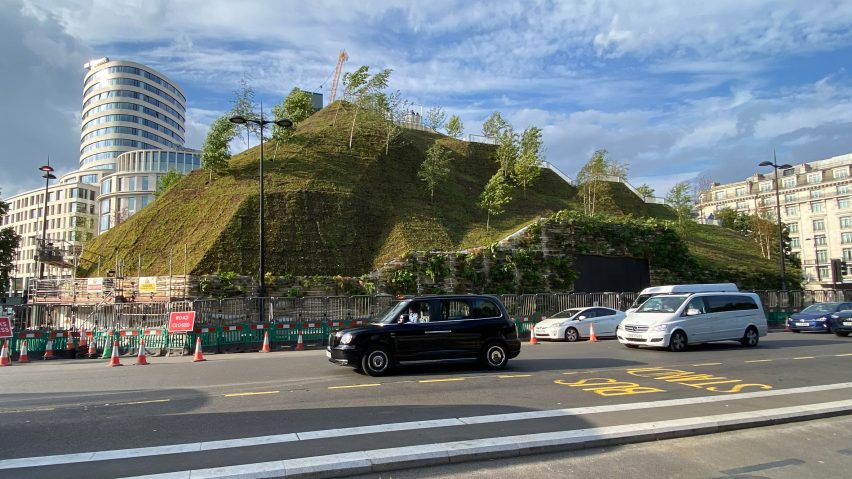Dutch studio MVRDV has blamed Westminster City Council's "nonchalance and laxity" for the disastrous Marble Arch Mound project, revealing that its design was watered down, its advice ignored and its design fee was 0.8 per cent of the total project cost.
"We have rarely seen such a loveless execution of our designs," said the Dutch studio in a statement on its website, adding: "We stand by our initial design".
Erected in central London last summer by Westminster City Council to draw people back to the Oxford street shopping district following coronavirus, the artificial hill was plagued with problems and widely criticised.
"Anyone who visited the Marble Arch Mound installation in London was no doubt severely underwhelmed," said MVRDV.
"Instead of an inspiring experience offering sweeping views over Hyde Park to provoke contemplation on the value of nature in cities, what visitors actually encountered was disappointing, to say the least."
MVRDV "systematically excluded from communication"
In its statement titled Learning form Marble Arch Mound, MVRDV placed the blame for the failure of the £6 million installation on decisions to reduce the scale of the project and exclude the studio from overseeing construction.
"Through a mixture of budget constraints and a lack of communication, many details concerning the mound's construction were decided without our involvement," said MVRDV.
Adding "over time we were systematically excluded from communication with the executive architect and landscape architect."
The studio stated that last-minute design changes led to the key decision to cover the mound in sedum, which contributed to the poor quality of the planting.
Its initial concept for a 25-metre-high platform that would extend above Marble Arch, informed by its Stairs to Kriterion project in Rotterdam, was abandoned due to concern from English Heritage and Historic England.
Investigations by these bodies "deliberately delayed" the project, leading to the installation being reduced in scale and moved alongside the monument, the studio said.
"The lush grass and shrub slopes initially proposed gave way to sedum and flowers," said the studio. "This we considered an acceptable compromise as sedum, if properly maintained, can remain completely green, even forming beautiful cushions."
When the arch opened on 26 July, the planting and sedum were in a poor condition, leading to the project being ridiculed by critics and forced to temporarily close. According to MVRDV, it had warned the council that the project was not in a state to be opened.
"Warnings from our side about a possible premature opening were ignored," said MVRDV. "The nonsensical decision to open the facility prematurely was nothing short of a disaster."
"We are also responsible"
The mound later reopened as a free attraction but was never completed to MVRDV's satisfaction. In the wake of the disaster and the overall costs rising from £3.3 million to £6 million, Westminster City Council's deputy leader Melvyn Caplan resigned.
"What should have been a celebration of London became a loveless installation that, with a few nice green plants here and there, provides a glimpse of what might have been," said the studio.
"In our thirty years of practice, MVRDV has never before experienced such nonchalance and laxity with our design work."
MVRDV acknowledged that it was also partly to blame for the debacle, stating: "Of course we are also responsible in this equation".
The studio cited its low fee of £10,000 to design the installation, which "implied a significant loss on the project with staff hours alone far exceeding this", as one issue.
"Perhaps we should not have worked for a fee so low that it allowed the client to sidestep the usual procedures," it said.
"We should have ended our participation"
But it cites its decision not to withdraw from the project once it was clear that it could not guarantee its quality as its "greatest sin".
"Perhaps when we were pushed out of the construction process we could have stepped out because we couldn't guarantee the project's quality," said the studio.
"This is certainly our greatest sin: we should have ended our participation precisely at that moment."
Despite all the issues and the criticism of the project, MVRDV stood by its concept.
"Among all these mistakes, we stand by our initial design," said the studio. "The Marble Arch Mound adheres to the MVRDV philosophy concerning the densification and greening of cities.
"That philosophy broadly includes the strategy of creating artificial nature in dense cities, as a means of raising awareness and changing perspectives on the way we perceive our built environment and the mixing of functions," it continued.
MVRDV is a Rotterdam-based studio that was founded by Winy Maas, Jacob van Rijs and Nathalie de Vries in 1991. As part of Dezeen 15 Maas proposed covering the entire planet with an inhabitable biostructure.
Dezeen is on WeChat!
Click here to read the Chinese version of this article on Dezeen's official WeChat account, where we publish daily architecture and design news and projects in Simplified Chinese.

